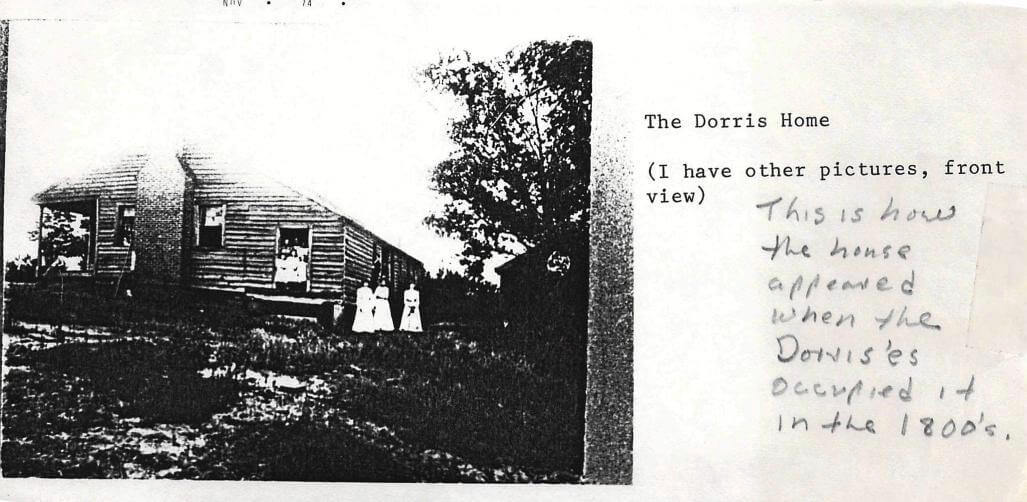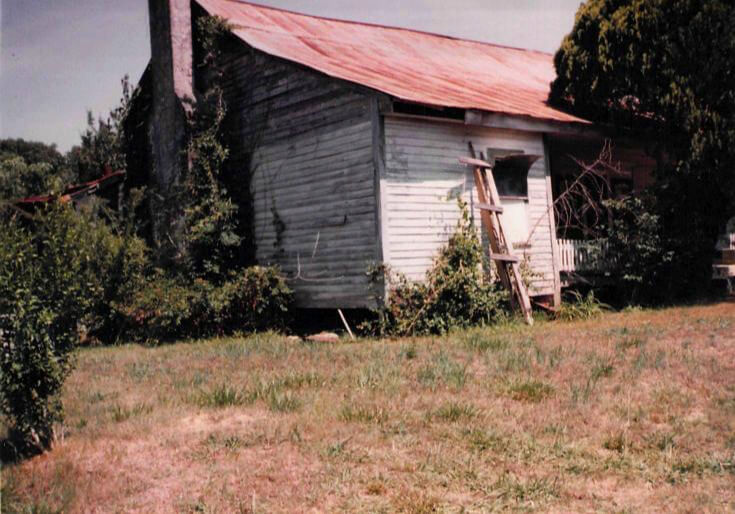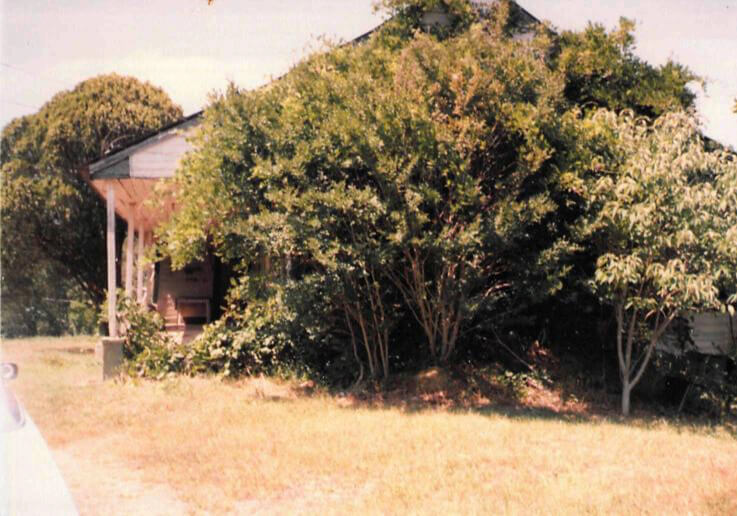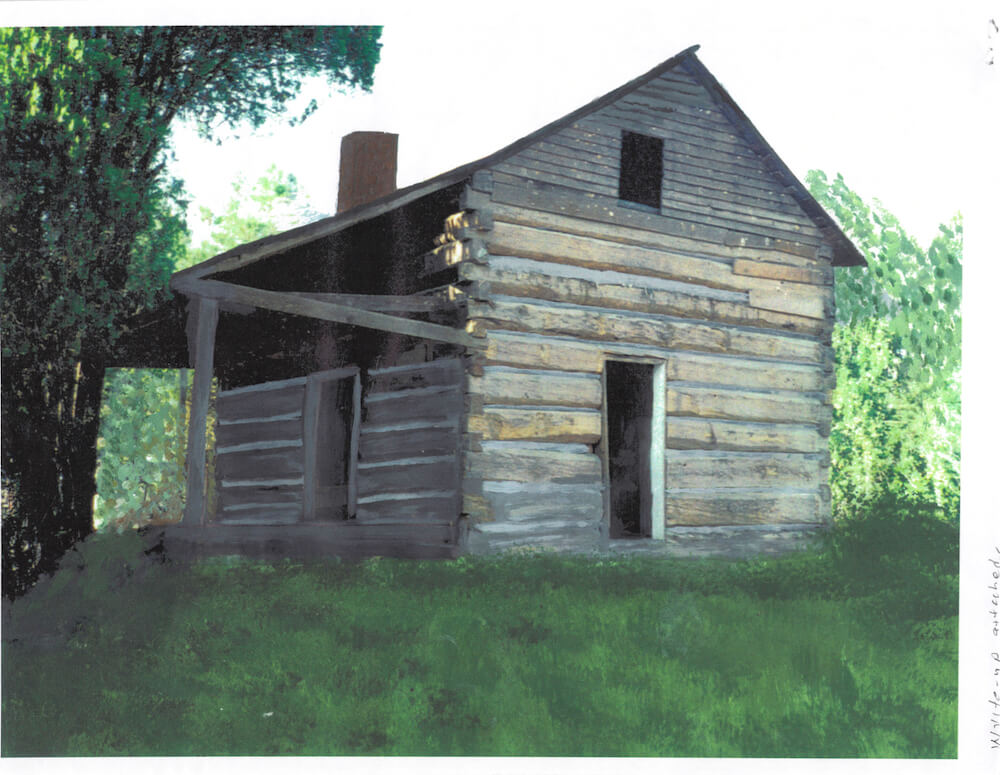The Log Cabin

Joseph Mitchell Dorris (Joe) as a teenager helped his parents build a 24’ X 36’ two story log cabin in 1837 (house was expanded in 1842).
It stood alongside now State Highway 413 about three miles south of Kilmichael, Mississippi. Joe married a local girl, Nancy Jane Powell. Perhaps Nancy was of the family for whom Powell’s Ferry Crossing was named. (Powell’s Ferry is what my generation called the Big Black River crossing between Winona and Poplar Creek.) The parents with younger members of the family moved to Grapevine, Texas.
There, Nancy and Joe had eight sons and four daughters born. They later added a much larger frame house to the log cabin. The house was built as most in its day. The front porch extended completely across the front of the house. A wide hall extended east and west the full depth of the house front to back. It was important for halls to be oriented east to west. A hall was a venturi that caused wind from the west to speed through. Winds south of Kilmichael generally blew west to east. It was the pioneer’s air-conditioning.

Joe and Nancy sent two of their younger sons through Harvard Business School. Two sons were sent through Clinton College (now Mississippi College) for preparation as schoolteachers. The other four sons and four daughters were not neglected as to education. Joe got with other neighbors in establishing the Dorris School a half mile south of the cabin. He donated the lot for the schoolhouse. Yours truly remembers going to a party at the Dorris school in 1928. It might have been a farewell party, because the Nations School opened in the fall of 1928. The students in the Dorris School transferred to the Nations school. Dorris School was named for Roy C. Watson’s great-grandfather Joseph Mitchell Dorris on on his mother’s side. Nations School was named for Roy C. Watson’s great-grandfather Starling Nations on his father’s side.
So, all of Joe’s children, male and female, were very literate. The primary object of education in the 1800s was to get the child to the level to be able to read the King James Version of the Holy Bible. The King James Version is commonly considered to have been translated into the high school level of English. My Uncle Walter Watson was a product of the Dorris School. He regularly used sophisticated math formulas in figuring out the things he would be building or repairing. Those people who attended the one room school of the 1800s and early 1900s, of which Dorris School was one were very literate.
Joe’s four college educated sons took Horace Greeley’s advice to go west. At the turn of the century, they owned much of Phoenix, Arizona. These sons were born in a modified log cabin.
Several years ago, a man bought the old Dorris house for its heart pine logs and lumber. Men with hand tools were able to dismantle the frame part. The logs of the log cabin required a tractor with a hydraulic rig to pull the logs apart. James Watson (nephew to Roy) was the rig operator. James said the hydraulic power was almost not a match for the pinning of the logs.

We laugh about ineptness in a person as being like a “square peg in a round hole.” To pin logs together, our forefathers drilled about 2 inch round holes down through logs at 90 degree joints and along the length of the log at intervals. Then they drove oversize square pegs down through the holes. Logs and pegs were of solid heart pine. Heart pine trees were those pine trees standing when the white man arrived. The pine trees grown since are mostly yellow pine sap with only the very center and knots having a red resin content. Heart pine is naturally impregnated by pine resin. Heart pine does not rot, and termites hate the taste of it. The ‘square pegs in round holes’ held log cabins together. The log cabin would be safer in tornadoes!
After the men had disassembled the frame part of the house, Ole Roy happened by. There stood the log cabin! Even though junk stood around the house, Roy got a camera and took pictures. After a color enlargement was made, Clarissa Watson painted out the junk. A copy of the retouched picture of the cabin is attached.

You may notice a beam set at an angle to a second as porch roof support. Mr. Ken P’Poole, of the State Department of Archives and History, assured me this cantilevered truss was for added support of the roof. This entire log cabin,except for door hinges and latches, would have come from trees very close to the site. Even shingles would have been riven from those heart pine trees. How many folks do you know who have resin impregnated shingles on their house? In that area, pine trees grow on the hills. Broadleaf trees grow in the swampy land.
The humble looking cabin was far more comfortable than some houses today. The cabin put its occupants close to the constant 65 degree temperature of the earth. My, we in the 2000’s are backward people!
This was written by Roy C. Watson sometime in the year 2000.